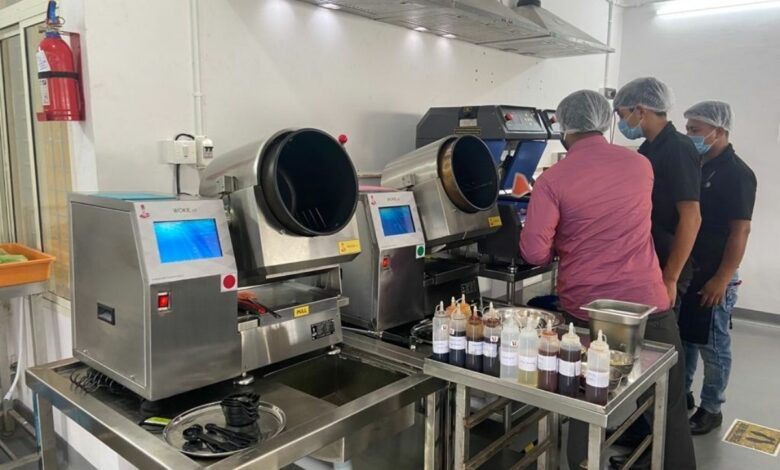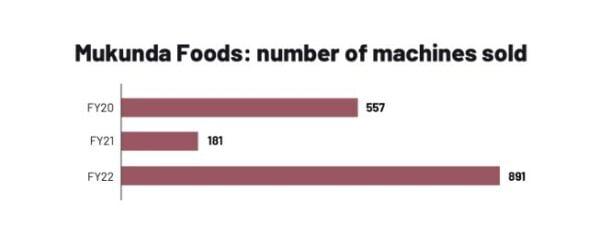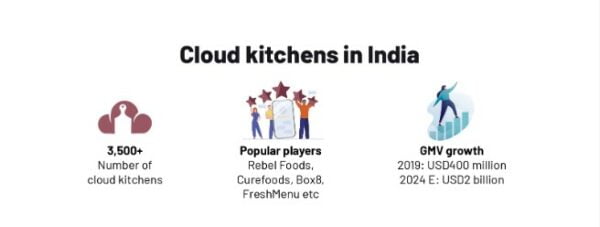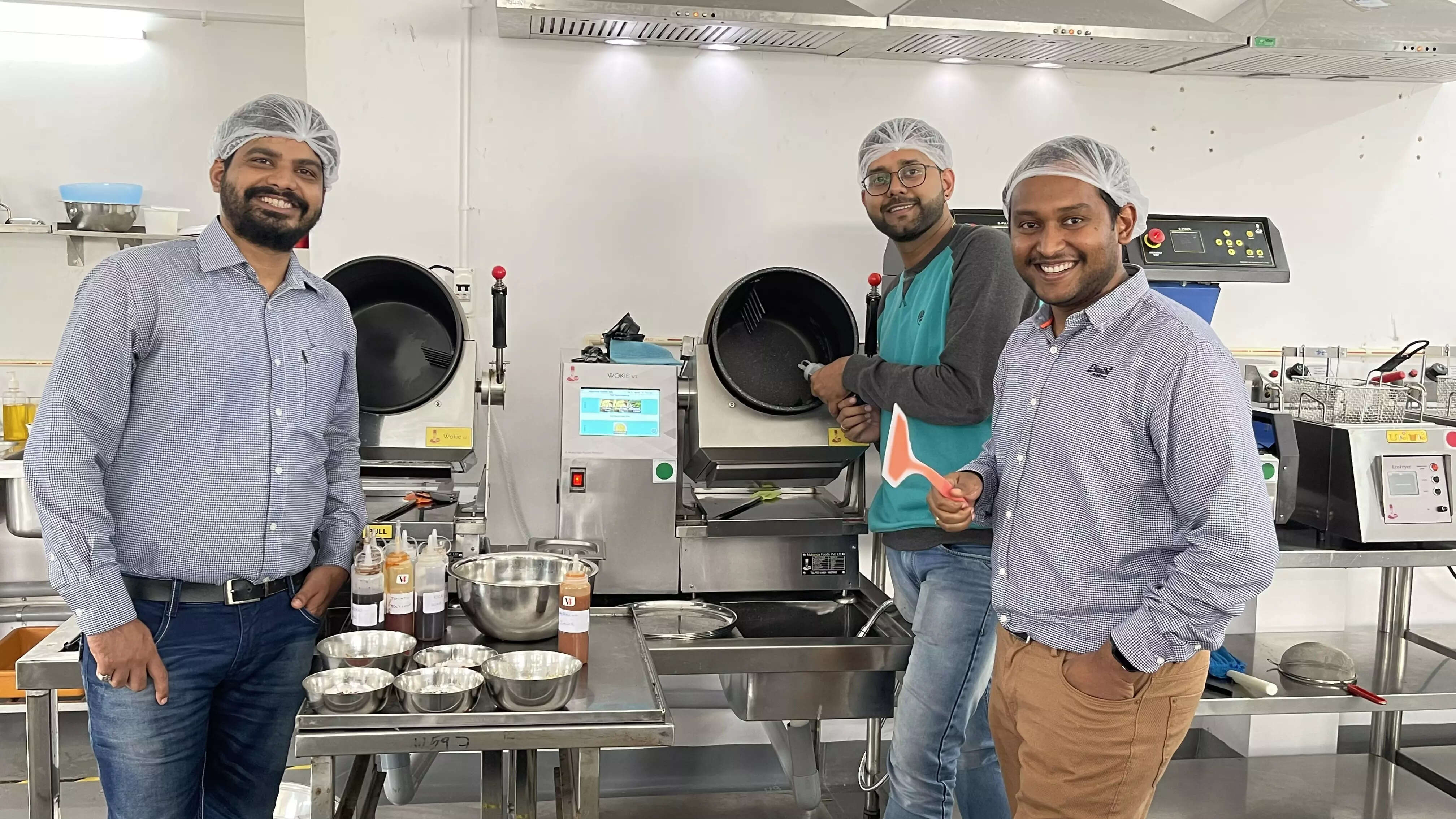Fast Food: Why can automated kitchens be the key to 10-minute deliveries?

They say smart ideas can come from anywhere. Eshwar Vikas (kitchen automation products maker) had a “light bulb” moment when he saw a concrete mixer at a building site. Those things made him want to start making Dosamatic, which is an automated cooking product for restaurants, back in 2015. Machine: It pumps out batter onto a hot pan and spreads it to a pre-set size and thickness. It makes crispy dosas in less than a minute.
Vikas’s company, Mukunda Foods, makes kitchen automation and robotics products. There are a lot of them, and the company sells automated works. One wok makes two minutes’ worth of fried rice, and the other cook’s frozen momos quickly. Today, companies like Mukunda Foods make it possible for food-tech companies to get food to people in 10 minutes.
Earlier this year, Zomato bought a 16.66 percent stake in the company that has been around for a decade. This month, a food-tech company will use Mukunda Foods’ products at its food stations, where it plans to start making 10-minute food deliveries from this month. Another company called Ola, which is also testing out food delivery in Bengaluru, has some of Mukunda Foods’ tools in its kitchens. Zepto, the first company in India to start delivering groceries in 10 minutes, also provides packaged food in 10 minutes in a few places in Mumbai.
Even the people who are setting the pace for quick delivery want to make them even faster. Domino’s Pizza, for example, has started cutting down the time it takes to get a pizza from 30 minutes to 20 minutes in most places. A company in India called Jubilant Foodworks says that 60% of its online orders now arrive in 20 minutes or less.
But, there are some issues with this model, as well. He got a lot of negative feedback from restaurants and customers when he announced the 10-minute delivery plan in March, and they were worried about the safety of delivery people. Another important question about the model was how good the food would be, and I asked if the food would be fresh or just heated up.
In the food industry, technology experts say that automation can make it possible to serve fresh food in just a few minutes.
Adoption of automation
At Mukunda Foods’ cloud kitchen in the Bommanahalli area of Bengaluru, the chef made shahi paneer in less than three minutes with an automated wok at the touch of a button. He had already made the base gravy, so he added paneer, cream, and spices to it. The Wokie machine would then whip it up in a matter of minutes. It tasted like any paneer dish served at a fast-food place (QSR).
It took two minutes for the chef to make some stir-fried vegetables in the wok, which were also good. A machine called Misty was used to make frozen momos into new ones, and it used pressure and a microwave to cook them in two minutes. The momos were soft, juicy, and kept their shape for a while. Every restaurant goes through this kind of thing, and some Mukunda Foods’ machines make it faster.
There are now a lot of food brands and restaurants that are all about automation. Wow! The 174 new Momo Foods stores that opened after the pandemic are all run by automation. We have worked with Mukunda Foods to make IP (intellectual property) products. We use their blast steamers and automatic fryers in our kitchens, says Sagar Daryani, the co-founder and CEO of Wow! Momo Foods, which makes IP products.
Wow! Momo has been making momos by hand for a long time and still does so in many of its 450 stores and outlets. Daryani says that “automation” is being looked at to make things more consistent and standard at all stores.
This is how it works: RoboChef is another company in the automated-kitchen field, but it has gone one step further. Saravanan Sundaramoorthy, the founder and CEO of RoboChef says that its kitchens are fully automated, so there is no need for a chef.
RoboChef has seven kitchens that brands can use as a kitchen-as-a-service.
Its equipment is used in about 50 kitchens in Chennai, Hyderabad, and Singapore. RoboChef also serves kitchens at schools and hospitals.
The five-year-old company has a multi-vessel and single-vessel system with digital recipes that can be used to make biryanis and curries, and other foods. Chef RoboChef’s cooking machines are also being used by restaurants that want to make a lot of different dishes at once in two to three minutes.
Food purists, on the other hand, aren’t sure about automation. The founder of Indigo Hospitality says that automation in the kitchen compromises the taste of the food. Anurag Katriar says that he tried to use automation in his kitchens a few years ago but didn’t go with it because it didn’t make sense.
Shakir Haq, the CEO of NKP Empire Ventures, which owns the popular Empire Hotels chain in Bengaluru and Mysuru, is very against this. When I cook food, I’ll never use a machine, and our menu doesn’t work with it. “I think it’s disrespectful to the customer if you try to make food in two or three minutes,” he says.
It’s also been challenging for many businesses to get started with robotic equipment in their kitchens because of how difficult it is to set up. People in the industry say that cloud kitchens need to make at least 30 portions of a dish to keep up with the demand when it’s the busiest. Machines aren’t very good at this right now, and it can make ten portions at a time, but Misty can only make three. There will have to be more machines in kitchens to meet the demand, which will cost more.
In general, each machine sold by Mukunda Foods costs about INR1.8 million to make. It sells a popular Wokie machine for INR2.5 lakh, which is a lot of money. For INR9 lakh, RoboChef sells a single-vessel unit that can make biryani for 20 people at a time. One crore Indian rupees is the price for a machine that can produce 20,000 portions of biryani.
If you want to make some food, you could use a machine. But when there are a lot of orders, it can be a big deal. Another thing: “Also, automation can work with a few items and not everything on the menu.” This person says that there is a place for automation, but only until the base ingredients are made. He says that automating things in the base kitchen, where items are prepped, is good but not at the store level.
There is no doubt that Haq of NKP Empire Ventures agrees with me. Building a processing plant outside of the city where we can use machines and technology to make and store our base ingredients is what we are working on. For example, to make gravies in bulk, we will have a set-up that will use hydraulics.
Kitchenomics
Mukunda Foods and other players like them also help restaurants save money by cutting down on labor costs, one of the highest costs. People who write about the business of restaurants say that this is what they say. It was found in the Pandemic report made by one of the daily news and O3 Capital that fixed costs make up 65% of the total costs for a restaurant. Labour and the expenses of running the store, like utilities and administrative fees, make up about 60% of the fixed costs.
In a cloud kitchen with 18-20 people who know how to cook, “our machines can help them make the same amount of food with only six or seven people,” says Vikas.
As of now, automation is only helping restaurants cut costs a little bit. Capex is also up because of this. Automation at Wow! Momo has cut operational costs by 3% to 4% over the last year, but Daryani says that CAPEX has increased by 30%.
Machine costs aren’t all that are needed to make momos. Cold chain investment is also required to keep them frozen until they’re ready to be cooked, which wasn’t required before because they were made by hand. He says there hasn’t been a significant change in the cash flow yet.
The food-automation companies had been having a hard time getting people to buy their products in bigger sizes. But it looks like that’s about to change.
By 2020, RoboChef has added 69 new machines to restaurants in India and Singapore that use its engines. She says that the company has seen a 300 percent increase in devices sales.
Mukunda Foods and other startups have also had problems with exclusivity contracts from clients like this. On the other hand, Mukunda Foods’ revenue in FY21 dropped from INR10 million to INR3 million on a year-over-year level. He says exclusivity contracts are the main reason for this drop in the stock market. Vikas says that for FY22, the company made INR18 million in revenue every month until June 2021.
As you can see, the restaurant industry is starting to get on board with semi-automated cooking.
Sales at Mukunda Foods rose from 181 last year to close to 900 in FY22. That’s up from 557 the year before.

Cloud kitchens: This is another way many restaurants are cutting costs after the virus. Speed is essential for cloud kitchens that only deliver food, and automation saves time.
People who write about the business of restaurants say that this is what they say. Cloud kitchens in India, run by companies like Rebel Foods, Cure Food, and FreshMenu, have more than 3,500. US$2 billion worth of cloud kitchens are expected to be sold by 2024, up from US$400 million this year.
Automation also helped QSRs come out of unscathed pandemic, which is how it works. A report says that people who work at fast-food restaurants were one of the few groups that did well during the pandemic. In 2021, McDonald’s, one of the world’s best QSRs and fast-food chains, raised the salaries of its employees by a lot of money.
In a study done by Mukunda Foods, the market for the company and other kitchen-automation machine manufacturers like the company is expected to reach USD27.4 billion by FY23 (for organized chains and standalone businesses). It says the industry will save more than three billion dollars a year by cutting back on workforce and food costs.

The debate is about whether or not it is essential to get things quickly.
The 10-minute delivery trend is catching on quickly, but some restaurants and brands aren’t sure if it’s worth getting on board.
Wow! Daryani, a member of Momo’s former camp, says he’s “excited” about the new girl. He says that the company is in the early stages of testing the service with Zomato.
I think there should be a 10-minute delivery service for food instead of going to the grocery store. When we’re hungry, we want food delivered in 10 minutes, but we’re willing to wait a little longer when it comes to groceries. Daryani says he’s sure he can get fresh food to customers in a few minutes. But he also knows about the risks. It’s important to me that the people who ride are safe. Then, “if that were to be broken, we would be morally wrong to stay away from it.”
The Indian Federation of App-based Transport Workers is worried about the quick-commerce trend that has become popular in many cities in the last few months. They say that there has been a rise in accidents. Zomato’s Goyal had been told that delivery partners would not have to ride more than 2 km because food stations would be close to customers, so they wouldn’t have to go far to get food.
But many restaurant owners, even those who work in the QSR business, think that 10 minutes is a long time to wait for a meal. One of the main rules for the order to be delivered in 10 minutes is that the food must be ready and out of the kitchen in three minutes. Even though we are a quick-service restaurant (QSR), I worry that this is a short time. Rahul Seth, the co-founder of Burger Singh, says that he hasn’t decided yet if he will work with Zomato on this.
This call isn’t happening until we figure out how to do things operationally. Seth says that the talks are going on.
Many restaurants that serve fine food don’t want to be a part of the new trend.
It’s a new idea, says Karan Kapur of K Hospitality Corp, which owns the TFS and Copper Chimney brands. “It’s a good idea,” says Kapur. However, the foodservice industry has a lot of different aspects. If you want to eat at Copper Chimney or Bombay Brasserie, you might not be able to do this. However, for quick-change menus, this could work.
When people are debating whether or not to use a specific model, they are all on the same page when it comes to what it will do to sales. “Seth says that this will increase the number of people who buy things.”
As a co-founder of restaurant-aggregation platform Thrive Now, Dhruv Dewan thinks that while 10-minute delivery isn’t a priority for the industry, it could help. People excited about this tend to be restaurants that already sell pre-packaged food, says the man.
The bottom line is:
The online food-delivery market, which is now worth about $4 billion and is growing at a rate of 19 percent, is expected to get a more significant boost from automation. The 10-minute model is seen as a substantial change in food delivery because it focuses on people who need food quickly, especially on workdays.
The co-founder of Bengaluru-based Voosh Technologies, a Y Combinator-backed startup, says, “We want to help people who need to order food.” Voosh recently started delivering food in 10 minutes from two cloud kitchens in the city.
The customer doesn’t have to spend a lot of time picking out what to eat. ” Saraswat says that we will ensure that the customer can place an order and finish the payment in 30 seconds. Voosh wants to open about 15 kitchens in the next few months.
Ola has also started selling “freshly made” food like pizzas, khichri, and rolls in 10 minutes through its quick-commerce arm, Ola Dash, in the Bellandur area of Bengaluru. This service is called Ola Dash. When Swiggy makes food for its brands, it uses some of the equipment caused by Mukunda Foods.
Many restaurants are still in a wait-and-see mode about the new trend, and they need to see how the model works before making a big move. There is a lot of money going into this, so businesses want to ensure that 10-minute delivery isn’t just a fad that will die out.
edited and proofread by nikita sharma

